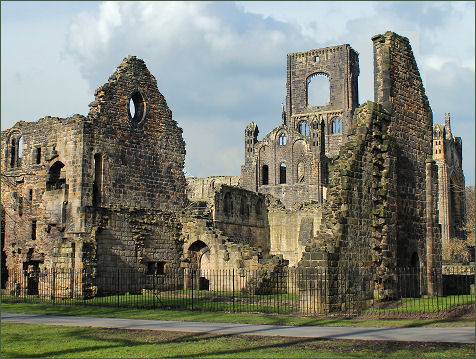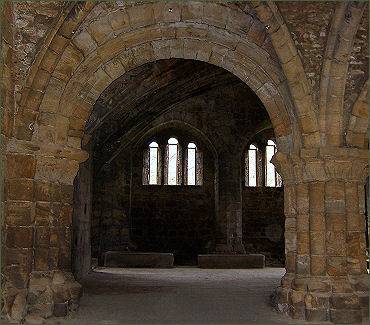Kirkstall Abbey
OS grid reference:- SE 257 361
 The ruins of Kirkstall Abbey, the most complete set of Cistercian ruins in Britain, are situated in Kirkstall, to the north-west of Leeds city centre. The abbey is set in a pleasant public park on the north bank of the River Aire.
The ruins of Kirkstall Abbey, the most complete set of Cistercian ruins in Britain, are situated in Kirkstall, to the north-west of Leeds city centre. The abbey is set in a pleasant public park on the north bank of the River Aire.
The abbey was founded by Henry de Lacy, the wealthy Lord of the manor of Pontefract. When de Lacy fell ill he made a vow that on his recovery he would establish a monastery and dedicate it to St Mary. When his health was restored, Henry donated land for the foundation of a monastery in the village of Barnoldswick, near the border between Lancashire and Yorkshire.
He granted the Abbot of Fountains Abbey the land at Barnoldswick on which to found a daughter abbey. Abbot Alexander travelled to Barnoldswick, along with twelve Cistercian monks from Fountains Abbey and made an attempt to build the new abbey on Henry de Lacy's land. The monks remained there for 6 years but found the site inhospitable, the monks were unable to grow crops, bandits stole their belongings,.
Abbot Alexander began a search for a more suitable site for his abbey and discovered a site in the then heavily wooded Aire Valley. Henry de Lacy helped acquire the land from William de Poitou. The buildings were largely completed between 1152 when the monks arrived in Kirkstall and the end of Alexander's abbacy in 1182.
At the Dissolution of the monasteries during the reign of King Henry VIII, the abbey was surrendered to Richard Leyton, the king's commissioner, by Abbot John Ripley on 22 November 1539. The abbey buildings escaped the wholesale destruction and plunder that occurred elsewhere and most were left standing. Abbot John received the abbey gatehouse to turn into his private home. This building later became Abbey House Museum, and some of its medieval features can still be seen.
 The estate was granted to Thomas Cranmer, Archbishop of Canterbury in 1542, but reverted to the crown when Cranmer was executed in 1556, during the reign of Henry's daughter Mary I. The estate was purchased by Sir Robert Savile in 1584, and it remained in the Savile family's ownership until 1671, when it passed to the Brudenell family, the Earls of Cardigan.
The estate was granted to Thomas Cranmer, Archbishop of Canterbury in 1542, but reverted to the crown when Cranmer was executed in 1556, during the reign of Henry's daughter Mary I. The estate was purchased by Sir Robert Savile in 1584, and it remained in the Savile family's ownership until 1671, when it passed to the Brudenell family, the Earls of Cardigan.
The picturesque ruins have been drawn and painted by artists such as J.M.W. Turner, Thomas Girtin and John Sell Cotman.
In 1889, the abbey was purchased by Colonel John North who donated it to the City of Leeds Corporation. The abbey was open to the public for the on 14th September 1895. The gatehouse became a museum.
Following a £5.5 million renovation programme, a new visitor centre was provided. The Kirkstall Abbey Visitor Centre informs visitors about the lives of the twelfth century monks and contains the touch table, a unique catalogue of images of the abbey from the eighteenth century to the present. Entrance to the Abbey itself is now through the visitor centre, which is free of charge, but with a donation box.
Abbeys and Churches of Yorkshire
